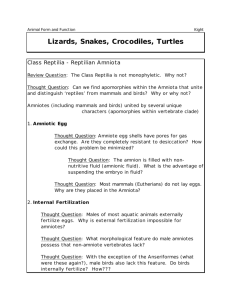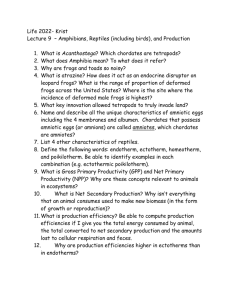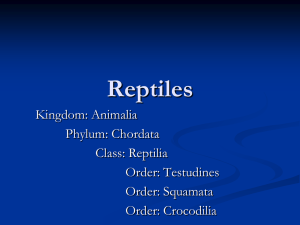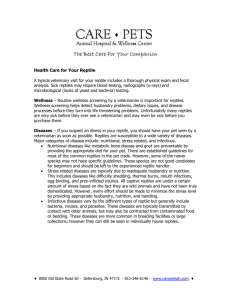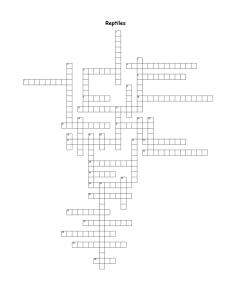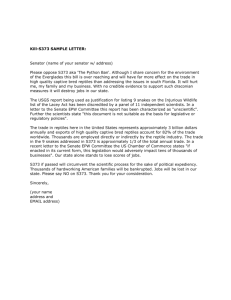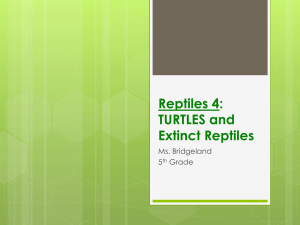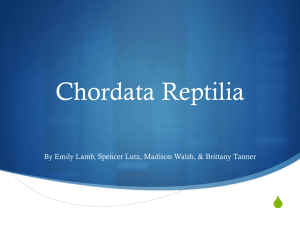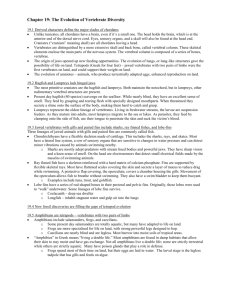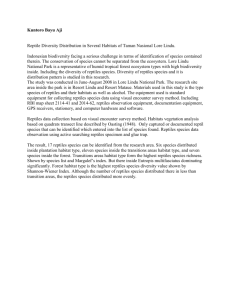Palaeos Vertebrates: Amniota
advertisement
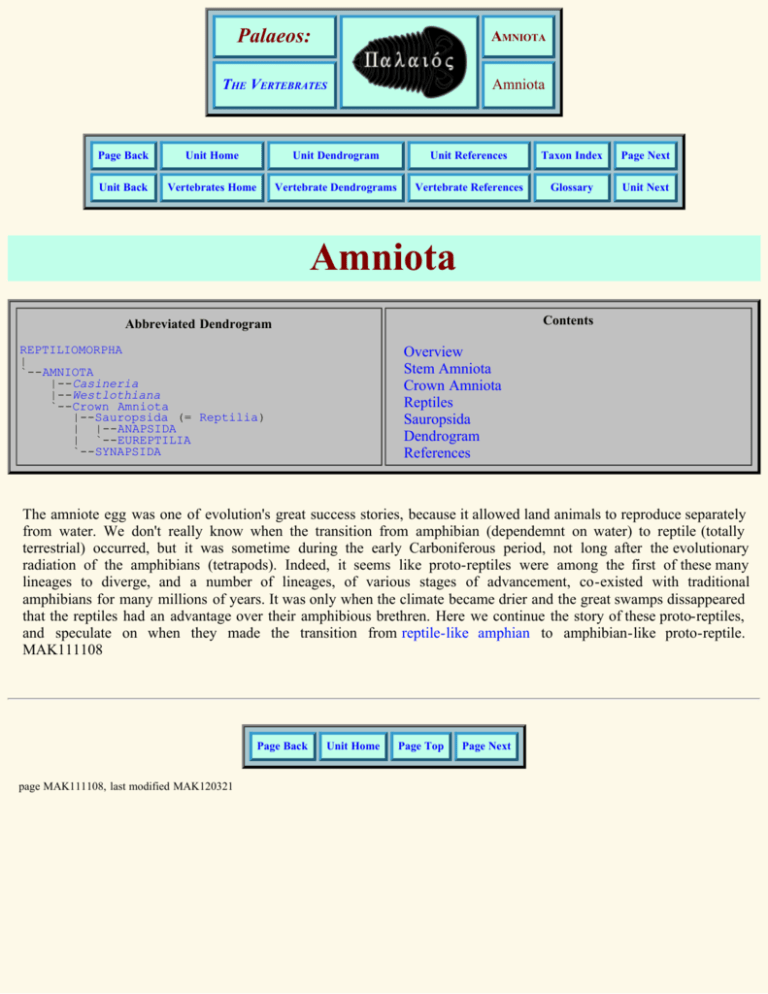
Palaeos: AMNIOTA THE VERTEBRATES Amniota Page Back Unit Home Unit Dendrogram Unit References Taxon Index Page Next Unit Back Vertebrates Home Vertebrate Dendrograms Vertebrate References Glossary Unit Next Amniota Contents Abbreviated Dendrogram REPTILIOMORPHA | `--AMNIOTA |--Casineria |--Westlothiana `--Crown Amniota |--Sauropsida (= Reptilia) | |--ANAPSIDA | `--EUREPTILIA `--SYNAPSIDA Overview Stem Amniota Crown Amniota Reptiles Sauropsida Dendrogram References The amniote egg was one of evolution's great success stories, because it allowed land animals to reproduce separately from water. We don't really know when the transition from amphibian (dependemnt on water) to reptile (totally terrestrial) occurred, but it was sometime during the early Carboniferous period, not long after the evolutionary radiation of the amphibians (tetrapods). Indeed, it seems like proto-reptiles were among the first of these many lineages to diverge, and a number of lineages, of various stages of advancement, co-existed with traditional amphibians for many millions of years. It was only when the climate became drier and the great swamps dissappeared that the reptiles had an advantage over their amphibious brethren. Here we continue the story of these proto-reptiles, and speculate on when they made the transition from reptile-like amphian to amphibian-like proto-reptile. MAK111108 Page Back page MAK111108, last modified MAK120321 Unit Home Page Top Page Next Palaeos: AMNIOTA THE VERTEBRATES Crown Amniota Page Back Unit Home Unit Dendrogram Unit References Taxon Index Page Next Unit Back Vertebrates Home Vertebrate Dendrograms Vertebrate References Glossary Unit Next Crown Amniota Contents Abbreviated Dendrogram REPTILIOMORPHA | `--AMNIOTA |--Casineria |--Westlothiana `--Crown Amniota |--Sauropsida (= Reptilia) | |--ANAPSIDA | `--EUREPTILIA `--SYNAPSIDA Overview Stem Amniota Crown Amniota The Amniotes Discussion of Phylogenetic Relationships Temporal Fenestration and the Classification of Amniotes Description Reptiles Sauropsida Dendrogram References Taxa on This Page 1. Amniota Note: the present page is concerned with the Crown Group Amniotes, that is, the most recent common ancestor of all living amniotes and all their descendants. It is very likely however that there were reptiles, that is, amniotes, existing before then, and even that some of these are already known from the fossil record. The problem is, it is very difficult to know exactly where amongst the various transitional forms between the amphian and reptilian condition reviewed in the previous pages the ability lay eggs on dry land first appeared. But the distinction on this page is not the physiological or evolutionary between pre-amniotes and amniotes, but the phylogenetic (family history of life) distinction between the first amniotes (and associated non-amniotes) and one particular group of later (though still very early and primitive) amniotes (reptiles) that became the ancestors of all later reptiles as well as mammals and birds. MAK111121 The Amniotes: Lungs: complex and in-folded, joined pharynx by trachea with cartilaginous support. Lungs used for CO2 dumping as well as O2 intake due to keratinized skin. Neck: Often lengthened and more flexible. Head: Buccal pumping eliminated, so head can be smaller and more domed. Skull: (Captorhinid) Like "Anthracosaurs" but no otic notch or intertemporal. Postparietal, tabular and supratemporal reduced and on occipital surface only. Supraoccipital supports posterior of braincase, large stapes supports it laterally. Transverse flange on pterygoid. Elimination of large fangs. Basicranial articulation with palate moveable. Basioccipital and exoccipital form occipital condyle. Fits in ring formed intercentra and arches of atlas: ball and socket joint. Palatoquadrate reduced to quadrate and epipterygoid. Lower jaw has 1-2 coronoids and splenial. Vertebrae: Spool-shaped centra. Small, crescentic intercentra. Ventral axial muscles: Development of intercostals used to move ribs in respiration. Ribs: lighter and may be joined ventrally by sternum as specialization for intercostal ventilation. Postural role assumed by epaxial muscles which are no longer primary locomotor muscles. Limb bones: lighter – possibly reflecting proprioreceptor system. Feet used as levers for propulsion, rather than holdfasts. Ankle forms distinct hinge joint (mesotarsal). Tibiales, other bones of pes fuse to form astragalus. 23453 manus, 23454 pes. Pelvis: Sacrum expanded from one vertebra to 2-3. Hearing: convergent development of stapes (hyomandibula) as principal sound conduction mechanism of middle ear (i.e. connects tympanum with inner ear). Excretion: Duct linking kidney & cloaca. Bladder not used as much for water recovery. This function tends to be performed by kidney. Amniotic Egg: additional membranes (amnion, allantois chorion) in egg act to permit gas exchange but avoid water loss, permit large amounts of yolk storage, isolate waste products during development. Temporal Fenestra: Synapsid at squamosal-postorbital-jugal, diapsid add at parietal-squamosal-postorbital. Euryapsid derived independently from diapsid by lack defined lower fenestra – loss of lower temporal bar. - ATW Discussion of Phylogenetic Relationships Michel Laurin and Jacques A. Gauthier (Tree of Life project - Creative Commons Attribution) Generations of systematists have studied amniote phylogeny at diverse genealogical levels, and until a few years ago, its broad outlines were thought to be reasonably well understood. Indeed, recognition of the major living clades, such as mammals, turtles and birds, antedates the Theory of Descent. Relations among these taxa, and especially the connections of various fossils to them, have been contentious in post-Darwinian times. Much of that controversy can, however, be attributed to the fact that during the first two-thirds of this century, there was little thought given to what constituted evidence for phylogenetic relationships. The origins of the major extant lines of Amniota have become clearer in the post-Hennigian era. Nevertheless, the precise relations of a number of clades, most notably the turtles among extant forms and the aquatic and highly divergent ichthyosaurs and sauropterygians among extinct forms, remain contentious. Early phylogenetic analyses placed turtles outside of the remaining amniotes (only crown-clade names are listed to simplify the trees): Gauthier et al. (1988a, b, and c) later placed turtles as the sister clade to Sauria (crown-diapsids), and this topology has now gained wide acceptance, at least among morphologists and paleontologists: However, Rieppel (1994, 1995), Rieppel & deBraga (1996) and deBraga & Rieppel (1997) have suggested that turtles may be the sister clade to lepidosaurs. This requires that turtles are saurians who have lost both the upper and lower temporal fenestrae (holes in the skull associated with jaw muscles) so diagnostic of diapsid reptiles: The three trees presented above include only extant taxa, and many phylogenetic analyses of amniotes have ignored extinct taxa. However, it is important to bear in mind that discovering the globally most parsimonious tree requires the inclusion of extinct taxa in a phylogenetic analysis (Gauthier et al., 1988b). Without fossils, the best-supported tree for amniotes inferred from morphological data is the following (although only one more step is required to switch the positions of lepidosaurs and turtles): Recent molecular evidence for amniote relationships conflicts with paleontological and morphological evidence. Initially, some gene sequences suggested a close relationship between birds and mammals, although never with strong statistical support (e.g., Bishop & Friday, 1987; Goodman et al., 1987; Hedges et al., 1990). More recently, a study of the molecular evidence for the origin of birds (15 genes; 5280 nucleotides, 1461 amino acids) discovered strong support (100% bootstrap P value, BP) for a close relationship between birds and crocodilians (Hedges, 1994). A smaller data set of 11 transfer RNA genes (686 sites) also resulted in a bird-crocodilian grouping (Kumazawa & Nishida, 1995). A basal position for mammals was supported (99% BP) by analysis of a 3 kilobase portion of the mitochondrial genome containing the two ribosomal RNA genes (Hedges, 1994). In the same study, a Sphenodonsquamate relationship also was found, but support for that grouping and for the position of turtles was not very strong. The most recent molecular phylogenies have generally placed turtles among archosauromorphs, and often within archosaurs (Mannen et al., 1997; Mannen & Li, 1999; Hedges & Poling, 1999; Hugall et al., 2007). The latter placement is the least compatible with the morphological evidence, and no convincing explanation has been found so far to explain this discrepancy. At least two total evidence analyses (in which molecular and morphological data are combined) suggest that turtles are not diapsids (Lee, 2001; Frost et al., 2006). In both, the molecular characters are much more numerous than the morphological ones, which implies significant support for the placement of turtles outside diapsids in these molecular datasets. Many gene sequences of birds and mammals exist, but the relatively small number of sequences from representatives of other amniote lineages, especially tuataras (Sphenodon) and turtles, has hindered the estimation of a robust molecular phylogeny for all major groups of living amniotes. This is reflected by the low resolution of the molecular phylogeny obtained by Hedges & Poling (1999) when Sphenodon (using only sequences of genes available in Sphenodon) was included: Without Sphenodon and using the greater number of sequences available for other taxa, Hedges & Poling obtained the following fully resolved phylogeny, in which turtles are the sister-group of crocodilans: Developmental data has rarely been used to study this question, but it has recently been found to place turtles outside diapsids (Werneburg & Sánchez-Villagra, 2009). If extinct amniotes are considered, the phylogeny is much more complex and controversial. Formerly, captorhinids were believed to be closely related to turtles (Gauthier et al., 1988b, c), but more recently, several groups of parareptiles have been sugested as closest relatives of turtles, such as procolophonids (Reisz & Laurin, 1991; Laurin & Reisz, 1995), pareiasaurs (Lee, 1993, 1994, 1995, and 1996), and Eunotosaurus (Lyson et al., 2010). Some paleontologists (Rieppel, 1994, 1995; Rieppel & deBraga, 1996; deBraga & Rieppel, 1997) place turtles among diapsids, especially as the sister-group of euryapsids (a group of Mesozoic marine diapsids). Phylogeny and Classification of Amniotes provides information about the phylogenies incorporating extinct amniote taxa, and provides a detailed classification of the relevant groups. Temporal Fenestration and the Classification of Amniotes discusses how temporal fenestration has been used to classify amniotes, and how tempororal fenestration evolved. References (Overworked editor's note: at some point these references need to be hyperlinked with the above, formatted (italics etc) and transferred to the reference page MAK111106) Bishop, M. J., & A. E. Friday. 1987. Tetrapod relationships: the molecular evidence. In Patterson, C (ed.) Molecules and Morphology in Evolution: Conflict or Compromise?: 123-139. Cambridge: Cambridge University Press. Campbell, N. A. 1993. Biology. 3rd edition. New York: The Benjamin/Cummings Publishing. Carroll, R. L. 1964. The earliest reptiles. Zoological Journal of the Linnean Society 45: 61-83. Coyne M. 1999. World's oldest reptile nest found. Marine Turtle Newsletter 83: 21. deBraga M. & O. Rieppel. 1997. Reptile phylogeny and the interrelationships of turtles. Zoological Journal of the Linnean Society 120: 281-354. Frost D. R., T. Grant, J. Faivovich, R. H. Bain, A. Haas, C. F. B. Haddad, R. O. de Sá, A. Channing, M. Wilkinson, S. C. Donnellan, C. J. Raxworthy, J. A. Campbell, B. Blotto, P. Moler, R. C. Drewes, R. A. Nussbaum, J. D. Lynch, D. M. Green, & W. C. Wheeler. 2006. The amphibian tree of life. Bulletin of the American Museum of Natural History 297: 1–370. Gaffney, E. S. 1980. Phylogenetic relationships of the major groups of amniotes. In A. L. Panchen (ed.) The Terrestrial Environment and the Origin of Land Vertebrates: 593-610. London: Academic Press. Gauthier, J. A. 1994. The diversification of the amniotes. In D. R. Prothero and R. M. Schoch (ed.) Major Features of Vertebrate Evolution: 129159. Knoxville: The Paleontological Society. Gauthier J., R. Estes, & K. de Queiroz. 1988a. A phylogenetic analysis of Lepidosauromorpha. In: R. Estes and G. Pregill (eds.) Phylogenetic relationships of the lizard families: 15-98. Stanford: Stanford University Press. Gauthier, J., A. G. Kluge, & T. Rowe. 1988b. Amniote phylogeny and the importance of fossils. Cladistics 4: 105-209. Gauthier, J., A. G. Kluge, & T. Rowe. 1988c. The early evolution of the Amniota. In M. J. Benton (ed.) The phylogeny and classification of the tetrapods, Volume 1: amphibians, reptiles, birds: 103-155. Oxford: Clarendon Press. Goodman, M., M. Miyamoto, & J. Czelusniak. 1987. Pattern and process in vertebrate phylogeny revealed by coevolution of molecules and morphologies. In C. Patterson (ed.) Molecules and Morphology in Evolution: Conflict or Compromise?: 141-176. Cambridge: Cambridge University Press. Hedges, S. B. 1994. Molecular evidence for the origin of birds. Proceedings of the National Academy of Sciences of the United States of America 91:2621-2624. Hedges, S. B., K. D. Moberg, & L. R. Maxson. 1990. Tetrapod phylogeny inferred from 18S and 28S ribosomal RNA sequences and a review of the evidence for amniote relationships. Molecular Biology and Evolution 7:607-633. Hedges S. B. & L. L. Poling. 1999. A molecular phylogeny of reptiles. Science 283: 998-1001. Hugall A. F., R. Foster, & M. S. Y. Lee. 2007. Calibration choice, rate smoothing, and the pattern of tetrapod diversification according to the long nuclear gene RAG-1. Systematic Biology 56: 543–563. Kumazawa, Y., & M. Nishida. 1995. Variations in mitochondrial tRNA gene organization of reptiles as phylogenetic markers. Molecular Biology and Evolution 12:759-772. Laurin, M. & R. R. Reisz. 1995. A reevaluation of early amniote phylogeny. Zoological Journal of the Linnean Society 113: 165-223. Laurin M. & M. Girondot. 1999. Embryo retention in sarcopterygians, and the origin of the extra-embryonic membranes of the amniotic egg. Annales des Sciences Naturelles, Zoologie, Paris, 13e SÈrie 20: 99-104. Laurin M. & R. R. Reisz. 1999. A new study of Solenodonsaurus janenschi, and a reconsideration of amniote origins and stegocephalian evolution. Canadian Journal of Earth Sciences 36: 1239-1255. Laurin M., R. R. Reisz, & M. Girondot. 2000. Caecilian viviparity and amniote origins: a reply to Wilkinson and Nussbaum. Journal of Natural History 34: 311-315. Lee, M., S. Y. 1993. The origin of the turtle body plan: bridging a famous morphological gap. Science 261: 1716-1720. Lee, M. The turtle's long-lost relatives. Natural History, April 1994, 63-65. Lee, M. S. Y. 1995. Historical burden in systematics and the interrelationships of 'Parareptiles'. Biological Reviews of the Cambridge Philosophical Society 70: 459-547. Lee M. S. Y. 1996. Correlated progression and the origin of turtles. Nature 379: 812-815. Lee M. S. Y. 2001. Molecules, morphology, and the monophyly of diapsid reptiles. Contributions to Zoology 70: 1-18. Li C., X.-C. Wu, O. Rieppel, L.-T. Wang, & L.-J. Zhao. 2008. An ancestral turtle from the Late Triassic of southwestern China. Nature 456: 497– 501. Lombardi J. 1994. Embryo retention and evolution of the amniote condition. Journal of Morphology 220: 368. Lyson T. R., G. S. Bever, B.-A. S. Bhullar, W. G. Joyce, & J. A. Gauthier. 2010. Transitional fossils and the origin of turtles. Biology Letters 6: 830–833. Mannen H., S. C.-M. Tsoi, J. S. Krushkal, W.-H. Li, & S. S.-L. Li. 1997. The cDNA cloning and molecular evolution of reptile and pigeon lactate dehydrogenase isozymes. Molecular Biology and Evolution 14: 1081-1087. Mannen H. & S. S.-L. Li. 1999. Molecular evidence for a clade of turtles. Molecular Phylogenetics and Evolution 13: 144-148. Modesto S. P. 1999. Observations on the structure of the Early Permian reptile Stereosternum temidum Cope. Palaeontologia Africana 35: 7-19. Reisz, R. R., & M. Laurin. 1991. Owenetta and the origin of turtles. Nature 349: 324-326. Rieppel, O. 1994. Osteology of Simosaurus gaillardoti and the relationships of stem-group sauropterygia. Fieldiana Geology 1462: 1-85. Rieppel O. 1995. Studies on skeleton formation in reptiles: implications for turtle relationships. Zoology-Analysis of Complex Systems 98: 298308. Rieppel O. & M. deBraga. 1996. Turtles as diapsid reptiles. Nature 384: 453-455. Rieppel O. & R. R. Reisz. 1999. The origin and early evolution of turtles. Annual Review of Ecology and Systematics 30: 1-22. Smithson T. R. 1989. The earliest known reptile. Nature 342: 676-678. Smithson T. R., R. L. Carroll, A. L. Panchen, & S. M. Andrews. 1994. Westlothiana lizziae from the VisÈan of East Kirkton, West Lothian, Scotland, and the amniote stem. Transactions of the Royal Society of Edinburgh 84: 383-412. Stewart J. R. 1997. Morphology and evolution of the egg of oviparous amniotes. In: S. Sumida and K. Martin (ed.) Amniote Origins-Completing the Transition to Land (1): 291-326. London: Academic Press. Werneburg I. & M. R. Sánchez-Villagra. 2009. Timing of organogenesis support basal position of turtles in the amniote tree of life. BMC Evolutionary Biology 9: 9 pages. Temporal Fenestration and the Classification of Amniotes (Tree of Life project - Creative Commons Attribution) Temporal fenestration has long been used to classify amniotes (Osborn, 1903). Taxa such as Anapsida, Diapsida, Euryapsida, and Synapsida were named after their type of temporal fenestration. Temporal fenestra are large holes in the side of the skull. The function of these holes has long been debated (Case, 1924), but no consensus has been reached. Many believe that they allow muscles to expand and to lengthen. The resulting greater bulk of muscles results in a stronger jaw musculature, and the longer muscle fibers allow an increase in the gape (Pirlot, 1969). An important distinction must be made between the type of fenestration found in certain taxa, and the taxa that were named after these types of fenestration. For instance, the anapsid condition is characterized by the lack of temporal fenestrae (Figure 1). As such, it is primitive for amniotes because all their close relatives lack temporal fenestrae. Anapsida (the taxon) includes turtles and their extinct relatives. While most members of this taxon (but not lanthanosuchids and some millerettids) have an anapsid skull, some extinct relatives of saurians (such as captorhinids and "protorothyridids") also had anapsid skulls. Four main patterns of temporal fenestrae in amniote skulls a) anapsids, b) synapsids, c) diapsids), d) euryapsids. (j. jugal, p. parietal, p.o. postorbital, sq. squamosal) (Benton, 2005). original url The synapsid condition is characterized by the presence of a single temporal fenestra bordered minimally by the jugal, postorbital, and squamosal. The quadratojugal and the parietal occasionally contribute to the edge of this fenestra. By comparison with diapsids, this fenestra can be called a lower temporal fenestra. All early members of Synapsida, the taxon that includes mammals and their extinct relatives, had a synapsid skull, but the temporal fenestra has been drastically modified in mammals by ventral processes of the frontal and the parietal that occlude the temporal fenestra. The location of the old fenestra is still visible between the zygomatic arch, the orbit, and the dorsal part of the skull, but it is no longer a hole in the skull. A few taxa not related to Synapsida have also acquired a lower temporal fenestra. These include lanthanosuchids (Ivakhnenko, 1980) and some millerettids (members of Anapsida). The diapsid condition is characterized by the presence of two temporal fenestrae, called the lower and the upper temporal fenestrae. The lower temporal fenestra is similar to the fenestra of synapsids, and it is generally bordered by the same bones (the jugal, postorbital, squamosal, and occasionally, the quadratojugal). The upper temporal fenestra is bordered by the postorbital, squamosal, parietal, and often, the postfrontal. This type of fenestration apparently appeared only once, in Diapsida, but it has been altered in many members of this taxon (squamates, and some early archosauromorphs, for example) by the loss of the lower temporal bar formed by the jugal and the quadratojugal. The last type of fenestration called euryapsid has been the most problematic, partly because the origin of this condition has long been debated. It now appears that this condition is modified from the diapsid condition, and that it appeared more than once. Euryapsid skulls have only an upper temporal fenestra, usually bordered by the parietal, postfrontal, postorbital, and squamosal. Examples of euryapsid skulls include Araeoscelis, a Lower Permian araeoscelidian, placodonts, nothosaurs, and plesiosaurs (marine reptiles of the Mesozoic). Euryapsida is a taxon that includes most known euryapsids, except for Araeoscelis (Rieppel, 1993). The condition found in ichthyosaurs is sometimes distinguished from the euryapsid condition because their temporal fenestra is only bordered by the parietal, postfrontal, and supratemporal (Pirlot, 1969). This condition has been called parapsid, but it only represents a minor variation on the euryapsid pattern. References Carroll R. L. 1981. Plesiosaur ancestors from the Upper Permian of Madagascar. Philosophical Transactions of the Royal Society 293: 315-383. Case E. C. 1924. A possible explanation of fenestration in the primitive reptilian skull, with notes on the temporal region of the genus Dimetrodon. Contributions from the Museum of Geology, University of Michigan 2: 1-12. Heaton M. J. 1979. Cranial anatomy of primitive captorhinid reptiles from the Late Pennsylvanian and Early Permian Oklahoma and Texas. Bulletin of the Oklahoma Geological Survey 127: 1-84. Ivakhnenko M. F. 1980. Lanthanosuchids from the Permian of the East European platform. Paleontological Journal 1980: 80-90. Laurin M. & R. R. Reisz. 1995. A reevaluation of early amniote phylogeny. Zoological Journal of the Linnean Society 113: 165-223. Osborn H. F. 1903. On the primary divison of the Reptilia into two sub- classes, Synapsida and Diapsida. Science 17: 275-276. Pirlot P. 1969. Morphologie évolutive des chordés. Montréal: Les Presses de l'Université de Montréal. Reisz R. R. 1981. A diapsid reptile from the Pennsylvanian of Kansas. University of Kansas Publications of the Museum of Natural History 7: 174. Rieppel O. 1993. Euryapsid relationships: A preliminary analysis. Neuen Jahrbuch für Geologie und Paläontologie. Abhandlungen 188: 241- 264. Descriptions Amniota: Range: from the Late Carboniferous. Phylogeny: Cotylosauria : Diadectomorpha + Stem Amniota : ?Casineria + ? Westlothiana * : Synapsida + Sauropsida. Characters: premaxilla with palatal, maxillary & nasal processes [MR05]; frontal contacts orbit; various patterns of fenestration related to additional musculature for jaw from dermal skull and development of musculature to supply static pressure at jaw; squamosal contributes to margin of posttemporal fenestra; hemispherical & ossified occipital condyle; pterygoid with distinct palatal surface, transverse flange and quadrate ramus [MR05]; pterygoid quadrate ramus with separate dorsal flange extending from basicranial articulation to dorsal process of quadrate, supporting elongate epipterygoid [MR05]; loss of labyrinthodont teeth, caniniform tooth present on maxilla; 2 centers of ossification in scapulocoracoid; astragalus present. Numerous additional characters listed above. Links: Introduction to the Amniota; Amniota; Amniota. References: Müller & Reisz (2005) [MR05]. ATW051015. Page Back checked ATW050518, new page MAK111106 Unit Home Page Top Page Next Palaeos: AMNIOTA THE VERTEBRATES Stem Amniotes Page Back Unit Home Unit Dendrogram Unit References Taxon Index Page Next Unit Back Vertebrates Home Vertebrate Dendrograms Vertebrate References Glossary Unit Next Stem Amniota Casineria and Westlothiana Contents Abbreviated Dendrogram REPTILIOMORPHA | `--AMNIOTA |--Casineria |--Westlothiana `--Crown Amniota |--Sauropsida (= Reptilia) | |--ANAPSIDA | `--EUREPTILIA `--SYNAPSIDA Overview Stem Amniota Crown Amniota Reptiles Sauropsida Dendrogram References Taxa on This Page 1. Amniota 2. Casineria X 3. Westlothiana X The first reptile A some point in evolutionary history, at a time when the first great coal swamps were only just emerging, and before even insects had taken wing, a tiny reptile-like amphibian aquired the ability to lay small waterproof eggs on land. This great grand mother of all reptiles, birds, and mammals (including us) probably wasn't more than 10 cm (or 4 inches in old imperial measurement), in length, and for all the world resembled a small salamander or lizard. It would have lived amongst leaf litter, rotten logs, and other hideaways, where it was safe from predators, and could scrurry after and munch happily on the numerous arthropods that even then inhabited the Earth. We don't know the transitiobnal stages that enabled it to liberate its reproductive cycle from water, culminating in the ability to lay waterproof eggs that hatched into miniature adult-like young, bypassing the amphibian tadpole stage altogether. We can be pretty sure that this creature was prior by some millions of years to the most recent common ancestor of all living reptiles birds and mammals, but we don't know exactly by how much, or how physiologically primitive or advanced it was. It may have resembled one of the two creatures featured on this page, or primitive(Solenodonsaurus featured on a previous page. Or it may have different to all of them. We do know that that that tiny creatuere was the beginning of one of the most successful animal clades to inhabit the Earth, the amniotes. MAK111109 Descriptions Amniota: The first physiological reptiles, and all their descendents Range: from the Early Carboniferous. Phylogeny: Cotylosauria : Diadectomorpha + * : Casineria + Westlothiana + Crown Amniota Comment: This taxon is erected here as a hypothetical apomorphy based node, defined by the presence of the first amniote egg. This stem-based taxon is prior to, and hence more inclusive than, the crown-based taxon (crown amniotes) referred to later. We don't know when this appeared, so the position of this clade is purely sp[eculative, as are the relations to it of the other taxa on this and related pages, which may or may not have been actual amniotes. MAK111121. Casineria: C. kiddi Paton, Smithson & Clack 1999 Range: Early Carboniferous (Asbian - Middle Visean) of Scotland. (Cheese Bay Shrimp Bed of the East Lothian Lower Oil Shale) Phylogeny: Stem Amniota : Westlothiana + Crown Amniota + * Comments: Poorly known form, known only from a headless partial skeleton, but with several tantalising early aamniote features, such as unfused ankles and clawed toes, five fingers, and gracile build with light leg-bones. Of course these may simply be convergences due to common adaption of a shared environment, or it may be that Casineria is indeed the earliest known reptile. In any case, this is the earliest known fully terrestrial tetrapod. The single tiny specimen shows bones that are strongly ossified (not cartiligeinous) indicating that the animal was almost or completely grown when it died. This ties in with the hypothesis proposed by Carroll that the first amniotes would have been very small, mo more than 10 cm, due to the initial lack of extra-embryonic membranes that are unique to amniotes (amnion, chorion, and allantois) and hence problems with build up of carbon dioxide (Carroll 1970, 1991, Laurin 2004 p.594). Initial cladistic analysis (Paton et al 1999) suggested a polytomy with Westlothiana and Eureptilia (Captorhinus, Paleothyris, Petralocosaurus), but the consensus tree was highly instable. Supertree analysis by Ruta et al 2003b place it close to Westlothiana, another enigmatic form, which may or may not be an amniote, and place both species outside a surprising clade in which diadectomorphs are nested in a paraphyletic amniota. For now we have tentatively and provisionally placed Casineria as a very primitive amniote. The generic name is is a latinization of Cheese Bay, the site near Edinburgh, where the specimen was found (not a native Australasian evergreen). Links: Out of the Swamps - How early vertebrates established a foothold with all 10 toes on land - Richard Monastersky .; Wikipedia; Jenny Clack - Other Early Tetrapod Projects (Casineria gets a brief mention) Image: Casineria kiddi holotype from Wikipedia; skeleton reconstruction and silhouette David Peters - Reptile evolution References: Paton et al 1999 MAK111106 Westlothiana: W. lizzaie Smithson & Rolfe 1990 Range: Early Carboniferous (Brigantian - Late Visean) of Scotland. (lower East Kirkton Limestone, West Lothian Upper Oil Shale Formation, Scotland) Phylogeny: Stem Amniota : Casineria + Crown Amniota + * Comments: named after the West Lothian district where it was discovered, and known from two nearly complete skeletons. A transitional form that combines amphibian and reptilian features, it was originally cosidered a a eureptile based on similarities of the skull, humerus, and vertebrae. Features that asociate it with amniotes rather than amphibians include unfused ankle bones, lack of labyrinthodont infolding of the dentin, a lack of an otic notch and a generally small skull. Later placed outside the amniote crown because of the absence of diagnosable characters, and now considered to belong on the amniote stem, close to either diadectomorphs or lepospondyls [1]. However its precise affinities remain uncertain, and the absense of crown group traits need not mean it is not an amniote, albeit a stem group amniote. As with Casineria , and in keeping with Carroll's hypothesi of amniote origins, these were small, terrestrial animals (total length 20 cm). The elongate body and small legs could be an adaption to burrowing, as with skinks. Image: Skeleton reconstruction and silhouette David Peters - Reptile evolution; life reconstruction Nobu Tamura Wikipedia References: Smithson & Rolfe 1990, van Tuinen & Hadly 2004, Wikipedia MAK111106 Note: [1] David Marjanovic, who at the time of writing is working on a very large cladistic analysis, argues is a basal lepospondyl with ordinary lepospondyl tabulars (See Dinosaur Mailing List) MAK111109 Page Back checked ATW050518, new page MAK111106 Unit Home Page Top Page Next Palaeos: AMNIOTA THE VERTEBRATES Reptiles Page Back Unit Home Unit Dendrogram Unit References Taxon Index Page Next Unit Back Vertebrates Home Vertebrate Dendrograms Vertebrate References Glossary Unit Next Amniota : Reptiles Contents Abbreviated Dendrogram REPTILIOMORPHA | `--AMNIOTA |--Casineria |--Westlothiana `--Crown Amniota |--Sauropsida (= Reptilia) | |--ANAPSIDA | `--EUREPTILIA `--SYNAPSIDA Overview Stem Amniota Crown Amniota Reptiles Sauropsida Dendrogram References Taxa on This Page 1. Reptilia A meditation on Reptiles Reptiles - those creeping, crawling, slithering, scaley, animals, dragons and dinosaurs, creatures of myth and folklore. Who hasn't had their imagination stirred by these creatures and their chthonic, typhonic, consciousness? Yet in order to understand reptiles and their place in the evolutionary history of life on Earth, we need to get rid of a few myths and misconceptions A lot of what the common person knows or thinks about reptiles is determined by cultural prejudice. The whole idea of the reptile, especially derived squamata, as the archetypal reptile, as a coldblooded, terrifying, evil and sinister creature, has its roots in teh Judae-Christian creation myth (bottom left), although its hould be pointed out that there are also more subtle and psychologically nuanced readings than the usual literalism. But it's just a small leap of unscientific imagination from the serpent in the Garden to Extraterrestrial shapeshifter (below center). Thebiblical phobia of creeping animals probably also ties in with the new paradigm meme of the reptilian brain as the most archaic, atavaistic, and savage stratum of brain evolution (below right) Negative, Western Judaeo-Christian inspired, images of reptiles: Judaeo Christian serpent in the Garden of Eden myth. according to a literalist religion , responsible, like women women for all of man's problems.; image from Serpent Mythology New Age conspiracy theory, according to which extraterrestrial reptilian aliens masquerade as public figures like the two President Bushes and and the British Royal Family ) as part of a dastardly alien plan for world domination. Image from Reptilian Resistance movement The the reptilian brain as pertaining to coldblooded hierarchical dominance. Image from Alice in Wonderland and the World Trade Centre Disaster by David Icke Not surprisingly, all of these myths and prejudices are incorrect. Rather than being "cold blooded", reptiles are poikilotherms, in that their body temperature varies according to environmental conditions or physiological activity (and in the tropics or even temeprate regions after being warmed by the sun or a period of activity they would be "warm blooded"), in contrast to homeotherms such as some fish, dinosaurs, birds, and mammals which maintain thermal homeostasis (feedback and equilibrium. In premodern worldviews, worms and snakes and other limbless crawling creatures are easily conflated, similar to the biblical confusion of birds and bats, The whole New Age reptilioid conspiracy theory (as well as ufo reptilians in general) can be memetically derived from (as well as chronologically predated by) the miniseries and television series "V"; serpents. The triune brain hypothesis, with its linear succession of reptilian old brain, paleomammalian limbic system, and neommalian neocortex, is no longer held to be a valid model of the evolution of the forebrain, classical reptiles rather than being savage and instinctual often display complex behaviour, intelligence, and even care of the young, birds (which are essentially modified (dinosaurian) "reptiles") have sophisticated neocortical learning fuctions, and some fish "limbic" style parental care [1]). Interestingly, in other religions, such as Hinduism, Hermeticism, and some forms of Gnosticism, which are based more in contemplative spirituality and meditation rather than authoritarian legalism, snakes have a much better reputation, being considered symbols of wisdom. We find this more positive association even in the current fantasy genre, where the dragon generally has a high status. Positive images of reptiles: Marble relief of Asclepius and his daughter Hygieia, with serpent. From Therme, Greece, end of the 5th century BC. Istanbul Archaeological Museums. Asclepius was the ancient Greek God of Medicine and Healing;. The rod of Asclepius, a Cambodian statue of the Buddha, shielded by the Naga (serpent being) Mucalinda (dated 1150 - 1175 c.e.); Asian Drawing by Theodoros Pelecanos, in alchemical tract titled Synosius (1478), depicting Ouroboros, the snake-entwined staff, remains a symbol of medicine today, although sometimes the caduceus, or staff with two snakes, is used instead. Photo by Prioryman, Wikipedia, GNU Free Documentation/Creative Commons Attribution Arts Museum in San Francisco. Photo by DoktorMax, Wikipedia, public domain serpent or dragon swallowing its own tail, a symbol of infinity. Photo by Carlos adanero, Wikipedia, public domain As someone who loves reptiles (and other creatures) the present author cannot help but feel more attraction for these positive images, and a strong antipathy for the negative, religious and conspiracy theory memes. But of reptiles themselves? Freed of human anthropocentrism and psychological projections both positive and negative, they are an assortment of animals living their own lives and evolving in their own direction. Their story is indeed a fascinating one, but whether reptiles even constitute a valid taxon is now a disputed in biology. Originally they were given the rank of class in the Linnaean system (although originally grouped by Linnaeus with the amphibians in his Systema Naturae). The Linnaean system howeveris a static classification, not a dynamic picture of the tree of the evolution of life on Earth. Our understanding of the evolutionary history of reptiles and their era they ruled the Earth seems to have passed through three broad stages. In the 19th century, ancient saurians caught the popular imagination with the great paleontological discoveries of the Victorian Age. Hence images of antediluvial monsters, primordial creatures of ancient swamps. This soon settled down to more serious science, although it was a while before dinosaurs were no longersprawling overgrown lizards. Four species of extant reptiles: Clockwise from above left: Spectacled Caiman (Caiman crocodilus), Green Sea Turtle (Chelonia mydas), Tuatara (Sphenodon punctatus) and Eastern Diamondback Rattlesnake (Crotalus adamanteus). Wikipedia By the late nineteenth and early twentienth century, Darwin's revolution had well and truly shaped scientific thinking, replacing early 19th century Owenist archetypes and Cuverian sequential creationisms of the early 19th century with a synthesis of Darwinian natural selection, Mendelian inheritence, population genetics, and paleontology and a sense of evolution through deep time. This is represented by the Evolutionary Systematics. Here the books of Romer and, on a less technical level, Colbert, informed a generation of budding paleo enthusiasts The diagram at the left can be compared with the similar diagram regarding the evolution of amphibians. Both have ancestral groups (ichthyostedids, cotylosaurs, thecodonts) from which radiate a whole slew of descendants; both have familiar and easily defined (in terms of recent species) categories such as classes Amphibia and Reptilia. Evolution of reptiles, graphic from Introductory Biology ECOL182R (Schaffer/Bonine/Ferriere) Spring 2009 Credited to Freeman 3rd edition Ch 27 (not sure what the book is called, but it is surprising to find this old repeeresentation (with mid 20th century vintage drawings) in a current text book (the only concession to current thinking is that Cotylosaurs are now referred to as "amphibians" (with a picture of Seymouria at the bottom) Among the advantages of evolutionary systematics is the emphasis on ancestral groups and clear and easily identifiable categories (we all know what a reptile is, or a bird or a mammal). The disadvantages are a lack of detail when it comes to the order of branching of the phylogenetic tree of life (instead there is simply a sort of star pattern radiating of many different groups from a general ancestor) and that, whilst familiar representatives of a group are recognisable (we easily associate a scaly crawling crocodile with "reptile", but what about a furry, warm-blooded pterosaur). Because of this, the characteristics that define the group as a whole can be generic or ambigious, and often both primitive ancestral and highly specialised or derived types often cannot be so easily identified. The phylogenetic-based cladistic system was an attempt to introduce precision into this whole arrangement. It does this by rejecting all paraphyletic groups. Here the old Class Reptilia becomes the paraphyletic taxon par excellence. This is because reptiles are defined only by shared primitive characteristics, essentially all amniotes that are not mammals or birds are reptiles; a cladistically meaningless statement (whether it is phylogenetically meaningless depends on your definition of phylogeny - evolutionary systamists and cladists use the same word in very different ways!). Instead, reptilia is replaced by a number of other nested clades, as shown in the diagram on the right. Here, the green shaded area represents the Linnaean taxonomic category "reptiles" (or Class Reptilia). This includes primitive synapsida - the pelycosaurs and therapsids (shown by the shading over the bottom half of the line leading to Synapsida; this is not technically the correct way to present a cladogram (the diagonal here would have to be divided into further branching points), but is still useful as a simple diagram) - but not advanced synapsids A rather imprecise diagram ("fish" are not a terminal or monophyletic taxon!) showing the relationship (mammals). It also inckudes turtles and tortoises (testudines), lizards and snakes between cladistic (diagonal lines) and traditional classification (shaded region) of the class Reptilia. The and their relatives (lepidosaurs), and crocodiles and many extinct related types, traditional definition of Reptiles is a paraphyletic assemblage compromising all amniote lineages, with but not birds (class Aves), despite their being closely related to crocs, as the the exception of birds and of mammalian synapsids. Vertebrata, Tetrapoda, Amniota, Sauropsida, and so on represent a nested series of clades. Each "lower" clade (in the diagram) includes diagrams. Obviously, the two systems are totally incompatible, which doesn't Diapsida, the next two above it. Diagram by Petter B�ckman, Wikipedia mean that one is wrong and the other right. Simply that they are two different ways of making sense of the natural, biological world. Of these two systems, cladstics has been almost universally adopted by vertebrate paleontologists, because it provides a standardised methodology for testing phylogenetic hypotheses (i.e. proposals about phylogeny, not the actual deep time historical fact of phylogenetic relationship). That doesn't mean that evolutionary systematics is automatically wrong, just its a different methodology; all these methodologies are useful each in their own way. For this reason, we retain use reptile here in both the colloquial, the Linnaean, and the evolutionary systematic, sense of four-legged or secondarily limbless, ectothermic (heat from external environment) or poikilothermic (body temperature varies widely) animals (more properly vertebrates) (apart from dinosaurs and pterosaurs which were it seems homeotherms) which lay shelled eggs (except for some snakes and Mesozoic marine reptiles that give or gave birth to live young), with a skin covered in scales and/or scutes (or secondarily smooth as with some of the afore-mentioned marine reptiles). If this sounds excessively vague, you can understand why many have made the switch to cladistics. On the other hand, it still serves, like "protist, "plant", "invertebrate", or "fish", as a useful generic term that is a lot easier to say and use then "any amniote that is not a bird or mammal". The same ease of use applies to other paraphyletic terms, which is why we have retained them, rather than resort to tedious phrases such as, to give just one example, "non-crocodylomorph, non-dinosaur, non-pterosaur stem-group archosaur/archosauriform" when the old 19th century term "thecodont" would in that instance serve quite nicely. As for the cladistic (as opposed to Linnaean) definition of Reptilia, which is the most recent common ancestor of all recent reptiles and all their descendents (see technical definition below.), this term is now redundant, since it depended on a particular group of prehistoric reptiles, called mesosaurs, diverging from the phylogenetic tree imemdiately after synapsids but before all other groups. Since this is now pretty much agreed not to be the case, clade Reptilia becomes synonymous with clade Sauropsida, assuming teh traditional hypothesis of turtles (testudines, chelonia) as anapsida holds. However, if turtles and their ancestors turn out to be diapsids (and more specifically crown group diapsids), that means only diverged much later. In thios case, Reptilia becomes a sub-clade of Sauropsida. All of which shows what a world of controversy something as unassuming as phylogeny can be. MAK111121, Image credits: Dragon, Dani 7C3, Wikipedia; Cladogram Petter B�ckman, Wikipedia, Evolution of reptiles from Schaffer/Bonine/Ferriere Notes [1] There was a time when one of us (MAK) was quite impressed with neuroscientist Paul MacLean's model, which was a standard part of the "New Paradigm" worldview of the late 70s and 80s and popularised by Carl Sagan (Dragon's of Eden), and also referred to by other authors such as Arthur Koestler and Erich Jantsch. But, as is so often the case, science moves on. See for example Bruce & Neary 1995, Lanuza et al 1998 (references via Neuro-Dojo), Striedter 2005, and Patton 2008 (refrences via Wikipedia) Descriptions Reptilia: LCA Turtles and birds (link). Range: from the Late Carboniferous. Phylogeny: evolutionary systematic definition: see stem amniota cladistic definition (1): Originally defined as Sauropsida: Mesosauridae + *: Anapsida + Eureptilia. Definition no longer holds, now that mesosaurs are almost universally considered anapsids, cladistic definition (2): LCA of all living reptiles. If turtles are anapsids, Reptilia is synonymous with Sauropsida. If they are diapsids, Reptilia is synonymous with Sauria. MAK111121 Characters: Tabular small or absent; large posttemporal fenestra; suborbital foramen (small hole near the lateral edge of palate, between the pterygoid, palatine, and ectopterygoid or jugal, when ectopterygoid absent); supraoccipital plate narrow. Links: Class Reptilia; THE EMBL REPTILE DATABASE; Reptilia - Suite101.com; Introduction to the Diapsids; Reptilia (Reptiles); Nuova pagina 1; BIOSIS | Resource Guide | Reptilia; Class Reptilia; Reptiles; Phylogeny and Classification of Amniotes; Photogallery: Reptilia \ Amphibia. ATW020623. Page Back checked ATW050518. New page MAK111105 Unit Home Page Top Page Next Palaeos: AMNIOTA THE VERTEBRATES Sauropsida Page Back Unit Home Unit Dendrogram Unit References Taxon Index Page Next Unit Back Vertebrates Home Vertebrate Dendrograms Vertebrate References Glossary Unit Next Amniota : Sauropsida Contents Abbreviated Dendrogram REPTILIOMORPHA | `--AMNIOTA |--Casineria |--Westlothiana `--Crown Amniota |--Sauropsida (= Reptilia) | |--ANAPSIDA | `--EUREPTILIA `--SYNAPSIDA Overview Stem Amniota Crown Amniota Reptiles Sauropsida Dendrogram References Taxa on This Page 1. Sauropsida The Sauropsids Sauropsida includes most of what was clasically known as "Reptilia" along with birds (which are in effect glorified reptiles) and of course dinosaurs. Sauropsids therefore are the bulk of the reptiles plus birds, while Synapsids are the "mammal-like reptiles" plus mammals. The first Sauropsids were probably primitive lizard-like creatures rather similar (and fairly closely related) to the protorothyrid Hylonomus, shown at right. They scurried through the Carboniferous undergrowth. In appearance and behaviour they would have been similar to modern lizards, although anatomically they were more primitive. At this time, the world was ruled by stem tetrapods. The only other amniotes around were a few basal synapsids. Both groups underwent a rapid evolutionary radiation as the Carboniferous and Permian proceeded. The synapsid "pelycosaurs" grew into 1 to 3 metre long predators, including specialized fin-back forms and two herbivorous lineages. The sauropsids remained small and lizard-like. Thus the dominant life-form during the Permian were synapsids, and, during the Late Permian, the therapsids which evolved from them. The end-Permian extinction, which saw off 95% of lifeforms on Earth, decimated both synapsids and sauropsids, but the sauropsids came back faster, with creatures such as the crocodile-like Proterosuchidae. These sprawling predators were the advance guard of a great army of scaly and armoured carnivores and herbivores (the Archosauriformes ), as well as the dinosaurs, during the Triassic period. Meanwhile the Triassic seas were the home of a variety of Sauropsid marine reptiles - ichthyosaurs, nothosaurs, and thalattosaurs. During the Late Triassic period the dinosaurs well and truly took over. The Synapsids were reduced to the role of mouse-sized rodents and insectivores; the mammaliforms and mammals of the Late Mesozoic. They remained in that lowly station, sharing the microvertebrate niches with a variety of lepidosaurs (lizards and lizard relatives), until a huge asteroid saw off the dinosaurs and the marine reptiles (the terminal Cretaceous extinction event) and the mammals were able to inherit the Earth. The surviving sauropsids include turtles, lizards, crocodiles and birds, all of which are still around today. The crocodile-like Choristodera were a major group (order) of reptiles that survive the terminal Cretaceous extinction but became extinct before the modern era, while the sphenodonts, the "lizards of the mesozoic" one could call them, are represented by a single endangered species on a few small islands off New Zealand. Descriptions Sauropsida: All amniotes closer to snakes than to St. Patrick. Range: from the Late Carboniferous. Phylogeny: Amniota : Synapsida + * : Reptilia + Eureptilia Characters: Little or no specialization along tooth row; $ maxilla separate from quadratojugal; $ single coronoid; some suborbital fenestra present; $ supinator process parallel to humeral shaft; $ 1 centrale in ankle; tail- based locomotion using lateral undulation; frequently bipedal; no glandular skin, uric acid waste, beta keratin. ATW010219. Comment: With Mesosauridae now included in the Anapsida, Sauropsida and Reptilia become synonymous. If turtles are diapsids then Reptilia become synonymous with whatever "eosuchian" clade includes the most recent common ancestor of all extant Sauropsids. MAK111105, Links: Phylogeny and Classification of Amniotes; Taxonomy browser (Sauropsida); Lecture 8 - Tetrapods; Amniota. ATW010219. Page Back checked ATW050518. New page MAK111105 Unit Home Page Top Page Next Palaeos: AMNIOTA THE VERTEBRATES Dendrogram Page Back Unit Home Unit Dendrogram Unit References Taxon Index Page Next Unit Back Vertebrates Home Vertebrate Dendrograms Vertebrate References Glossary Unit Next Amniota: Dendrogram Contents Abbreviated Dendrogram REPTILIOMORPHA | `--AMNIOTA |--Casineria |--Westlothiana `--Crown Amniota |--Sauropsida (= Reptilia) | |--ANAPSIDA | `--EUREPTILIA `--SYNAPSIDA Overview Stem Amniota Crown Amniota Reptiles Sauropsida Dendrogram References This is surely one of the smaller dendrogram pages on Palaeos, as not much is known regarding stem amniotes. We have tentatively placed Casineria and Westlothiana here, as they fit the expected pattern of miniaturisation combined with advanced amniote features, but they could just as easily as easily go among the Reptiliomorpha. Most cladistic analyses actually place those two taxa beneath the diadectomorphs (almost certainly amphibians) and Solenodonsaurus, leaving the amniote ancestor unknown; the present author considers this could also be an artifact of diadectmorph convergence with early reptiles; as with multiple mammal-like lines of therapsids and bird-like lines of coelurosaurs there were clearly a number of lineages indepedently evolving in the same direction. MAK120321 REPTILIOMORPHA | `--AMNIOTA |--Casineria •X |--Westlothiana •X `--Crown Amniota MH, ToL |--+--Sauropsida MH / Reptilia | |--ANAPSIDA | `--EUREPTILIA `--SYNAPSIDA Page Back checked ATW050518, new page MAK111106, revised 120321 Unit Home Page Top Page Next Palaeos: AMNIOTA THE VERTEBRATES References Page Back Unit Home Unit Dendrogram Unit References Taxon Index Page Next Unit Back Vertebrates Home Vertebrate Dendrograms Vertebrate References Glossary Unit Next Amniota: References Contents Abbreviated Dendrogram REPTILIOMORPHA | `--AMNIOTA |--Casineria |--Westlothiana `--Crown Amniota |--Sauropsida (= Reptilia) | |--ANAPSIDA | `--EUREPTILIA `--SYNAPSIDA Overview Stem Amniota Crown Amniota Reptiles Sauropsida Dendrogram References Benton, M.J. 2005. Vertebrate palaeontology. 3rd ed. Blackwell publishing, Oxford. Temporal Fenestration and the Classification of Amniotes Bruce LL, Neary TJ. 1995. The limbic system of tetrapods: A comparative analysis of cortical and amygdalar populations. Brain, Behavior and Evolution 46(4-5): 224-234. Reptiles - note Carroll, R. L. 1970. Quantitative aspects of the amphibian-reptilian transition. Form. Funct. 3:165–178. Casineria Carroll, RL (1988), Vertebrate Paleontology and Evolution, W. H. Freeman and company, New York Carroll, R. L. 1991. The origin of reptiles. Pages 331–353 in Origins of the higher groups of tetrapods—controversy and consensus (H.-P. Schultze, and L. Trueb, eds.). Cornell University Press, Ithaca. Casineria Lanuza E, Belekhova M, Martinez-Marcos A, Font C, Martinez-Garcia F. 1998. Identification of the reptilian basolateral amygdala: an anatomical investigation of the afferents to the posterior dorsal ventricular ridge of the lizard Podarcis hispanica. European Journal of Neuroscience 10(11): 3517-3534. Reptiles - note Laurin, M. 2004, The Evolution of Body Size, Cope's Rule and the Origin of Amniotes Syst. Biol. 53(4):594–622, 2004 DOI: 10.1080/10635150490445706 Casineria Müller, J & RR Reisz (2005), An early captorhinid reptile (Amniota: Eureptilia) from the Upper Carboniferous of Hamilton, Kansas. J. Vert. Paleontol. 23: 561-568. Amniota Patton, Paul (2008). "One World, Many Minds: Intelligence in the Animal Kingdom". Scientific American. December, 2008 Reptiles - note Paton RL Smithson TR and Clack JA 1999. An amniote-like skeleton from the Early Carboniferous of Scotland. Nature 398: 508-513. Casineria M. Ruta, M. I. Coates, and D. L. J. Quicke. 2003a. Early tetrapod relationships revisited. Biological Reviews 78(2):251-345 Ruta, M., Jeffery, J. E. and Coates, M. I. 2003b. A supertree of early tetrapods. Proceedings of the Royal Society of London Series B-Biological Sciences 270: 2507-2516. . pdf Casineria Smithson, T.R. & Rolfe, W.D.I. (1990): Westlothiana gen. nov. :naming the earliest known reptile. Scottish Journal of Geology no 26, pp 137-138. Westlothiana Striedter, G. F. (2005) Principles of Brain Evolution. Sinauer Associates. Reptiles - note van Tuinen M, and Hadly EA (2004) Error in estimation of rate and time inferred from the early amniote fossil record and avian molecular clocks. J. Molecular Evolution 59(2): 267-276. pdf Westlothiana Page Back checked ATW050518, last revised MAK120321 Unit Home Page Top Page Next
